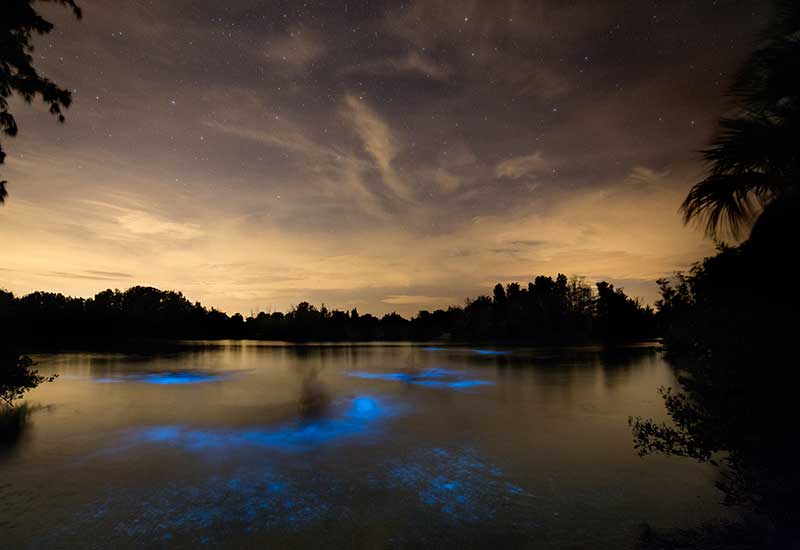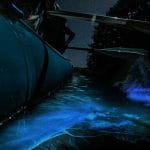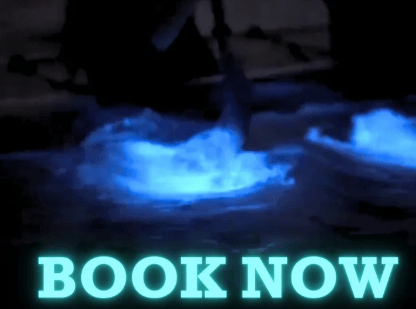
Bioluminescence at Indian River, Merritt Island Wildlife Refuge, Florida. Photo by: Derek Demeter; Director of the Emile Buehler Planetarium at Seminole State College.
At BK Adventure we get a lot of questions about bioluminescence as the #1 tour provider in Florida. Our team biologist guides put together these facts about the glowing dinoflagellates and comb jellies in the Indian River Lagoon, Florida. BK Adventure does tours nightly on Florida’s bioluminescent lagoon.
What is Bioluminescence?
- Light produced or emitted by organisms through biochemical reactions. Simplified: chemical reactions that take place in living things which release energy in the form of light.
- Uses: Acts somewhat as an alarm system when the organism is excited/disturbed/stimulated. Some other uses include communications to other members of the species, to evade or warn predators and lure in prey.
What color is bioluminescence?
- In water, it is usually blue greenish. Why? Red light is the first in the light spectrum to be absorbed in water so it does not penetrate or travel very far. Blue light travels the deepest and furthest in water. Also, marine organism are sensitive to mainly or only light near the blue spectrum.
Where is bioluminescence in Florida?
- Merritt Island Wildlife Refuge near Titusville
- Indian River Lagoon near Titusville
- Banana River near Cape Canaveral
- Kiwanis Island near Cocoa Beach
What organisms mainly contribute to the bioluminescence in Florida’s Indian River Lagoon?
[list type=”check”]
- Dinoflagellates
- Comb Jellyfish
- Fireflies (Lightening Bugs)
- Snapping Shrimp (sono-luminescent)
[/list]
When is the Best Time to See Bioluminescence?
[list type=”check”]
- The warmest months of the year are the best times to see bioluminescent plankton, like Dinoflagellates. That is because they multiply in “blooms.” The warm water makes them abundant and they blanket the water. Usually bioluminescent plankton begin to appear in May and can last through October.
- Colder months are better to see comb jellies. They are always present, but the colder water makes them rise to the surface where they are more visible.
- Check the Bioluminescence New Moon Calendar to see the best times to view
[/list]
What are Dinoflagellates (bioluminescent plankton)?
- Scientific name: Pyrodinium bahamense
- First discovered in 1906 off the coast of the Bahamas.
- It is a single cell organism. Microscopic.
- Photosynthesize during the day time (like plants). Photosynthesis is how they get their energy or “food”. They use this energy to produce bioluminescence at night.
- Part of a group called phytoplankton- Plankton that photosynthesize.
- Phytoplankton such as the dinoflagellates in the IRL produce up to 50% of the planet’s oxygen. How? There is more water than land on earth, this water is filled with phytoplankton producing oxygen everyday.
- When the organism receives pressure on its cell walls chemical reactions take place and causes the bioluminescence. Predators may shy away from the light thus the dinoflagellate avoids being eaten (Alarm system), or the predator’s location is revealed thus it becomes prey for other organisms.
- They produce a powerful light that is hundreds of times greater than their actual size.
- Usually referred to as Plant-like organisms.
- Body is composed of plate like structures and a flagellum (looks like a little tail) that it uses to swim.
- Main predators include filter feeders (oysters, barnacles etc.), zooplankton or fish that feed on plankton. The Northern end (Haulover canal) of the IRL is where it is most abundant in the lagoon because ocean water isn’t flushing it at a high enough rate and may be due to low population on filter feeders in the area.
- Most abundant in Summer months because days are longer (Sun=food) and conditions (salinity, pH, turbidity, predation etc.) are ideal.
- Locals used to refer to the phenomena as “Fire Water” because as the boats were in motion it appeared as though the water was on fire.
- May be toxic (*Guests not to worry, usually only through the consumption of shellfish or fish like the puffer fish in the IRL Northern end).
- Reproduce through cell division.
- Believe to operate on an internal clock or rhythm (circadian rhythm), photosynthesize at day, rest and bio-illuminate at night. Same way we get sleepy at night and active in the day if we are trained this way long enough.
What are Bioluminescent Comb Jellyfish (comb jellies)?
- Scientific Name: Mnemiopsis leidyi
- NOT an actual jellyfish. It is a Ctenophore, pronounced: Ten-uh-fours. Remember 10:04’s.
- Jellyfish have one opening where they eat and excrete; Their mouth is also their butt. Ctenophores however have two separate openings, one for eating and the other for excreting.
- Life span is a few months
- They look like a walnut of goo.
- Produces bioluminescence to stun predators.
- They have eight rows of cilia or “combs”. These are tiny little appendages or hairs that move back and forth and allow the organism to swim. These combs refract light (think of Pink Floyd’s Dark side of the Moon album cover. Light goes in one side and is separated into different spectrums on the other) and create the effects of different colors lights moving up and down the combs. So even in the day time when diving or snorkeling, you can observe comb jellies refracting the available light into different colors like a rainbow.
- About 95% water
- Do not sting
- Two ways of feeding: They have sticky feeding tentacles that capture prey. They also swim with their lobes or “body” open and any food that passes their mouth gets ingested.
- They are GREEDY! Why?
- May eat up to 10 times it’s weight in food per day
- They appear to not get full. As long as food is available they will continue to eat. What they can’t fit in their bodies they vomit out but continue to eat.
- They are hermaphrodites (male and female simultaneously). They release sperm and egg in the water. They can self-fertilize. They do not need other individuals to reproduce. They can produce up to 10,000 eggs if large enough and enough food is available.
- They mainly feed on zooplankton (typically the larger plankton) as well as meroplankton like fish larvae and eggs. They can be cannibalistic and eat other comb jellies as well.
- When are they common (best time to see)? Most common in Winter in the IRL. Why? Possibly: 1.Upwelling. Cold water is more dense than warm water. In summer months warm water stays at surface and cold water stays below. Cold water has more nutrients and oxygen. In winter the different waters mix and is more nutritious. More nutrients = more food = more comb jellies. 2. Its predators may be more common in the summer months. This has to do with their life cycles.
- They seem to prefer brackish and polluted near shore waters.
- Do they have a Brain? No, they have what is called a nerve net, helps them to sense changes in water chemistry or the presence of other organisms. They also have specialized structures that help them detect what position they are in the water (upside down etc.)
- They can be invasive in other parts of the world and crash fisheries; they reproduce too quickly and consume too many fish eggs and larvae.
Where to Do A Florida Bioluminescence Tour?
Click here to see all of BK Adventure’s Bioluminescent Tours. Tours launch nightly from several locations on the Indian River Lagoon, including the Merritt Island Wildlife Refuge near Kennedy Space Center, and on the Banana River near Cocoa Beach. BK Adventure is the only company to offer a variety of Bio Bay Tours, including Family Rafting, Completely See-Through Clear Kayaks, and Double Kayaks. These tours are on the east coast of Central Florida about 1 hour away from Orlando and the Disney Resort Area. Booking is easy online or by calling 407-519-8711 (open until 8pm).










Not good got tons of bites on bot Bhararan
Legs and itching
There is a school of fish in my Cape Coral canal tonight with the ability to generate short bursts of white light – they appear to be over 10 inches in length so they are jellyfish or plankton. Can you suggest what they are? Thanks